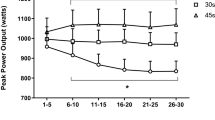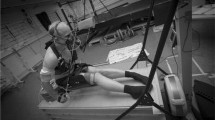Abstract
The purpose of this study was to investigate the effect of two cycling velocities on power output and concomitant metabolic and cardiorespiratory responses to repeated all-out exercises. Mean power output (P m), total work (W tot), total oxygen consumption (VO2tot) and blood lactate accumulation (Δ[La]b) were evaluated in 13 male subjects who performed two series of twelve 5-s bouts of sprint cycling. Recovery periods of 45-s were allowed between trials. One series was executed at optimal velocity (V opt: velocity for greatest power) and the other one at 50% V opt (0.5V opt). Velocities obtained in these conditions were Vopt=116.6 (4.7) rpm; 0.5Vopt=60.6 (4.9) rpm. After a phase of adaptation in oxygen uptake in the first part of the series, the data from the 6th to the 12th sprint were as follows: P m, 924.6 (73.9) versus 689.2 (61.8) W; W tot, 29.95 (4.14) versus 22.04 (3.17) kJ; VO2tot, 12.80 (1.36) versus 10.58 (1.37) l; Δ[La]b, 2.72 (1.22) versus 0.64 (0.79) mmol.l−1, respectively (P<0.001). Both W tot and VO2tot were consistently higher at optimal velocity (+21 and +35.8%, respectively). The present findings demonstrate that during intermittent short-term all-out exercise requiring maximal activation, the energy turnover is not necessarily maximal. It depends on muscle contraction velocity. The increase, lower than expected, in metabolic response from 0.5V opt to V opt suggests also that mechanical efficiency is higher at V opt.







Similar content being viewed by others
References
Altman PL, Ditmer DS (1968) Metabolism, section VI. FASEB, Bethesda, Md., pp 327–406
Arsac LM, Belli A, Lacour J-R (1996) Muscle function during brief maximal exercise: accurate measurements on a friction-loaded cycle ergometer EurJ Appl Physiol 74:100–106
Balsom PD, Seger JY, Sjödin B, Ekblom B (1992) Maximal-intensity intermittent exercise: effect of recovery duration. Int J Sports Med 13:528–533
Bangsbo J, Gollnick PD, Graham TE, Juel C, Kiens B, Mizuno M, Saltin B (1990) Anaerobic energy production and O2 deficit-debt relationship during exhaustive exercise in humans. J Physiol (Lond) 422:539–559
Beelen A, Sargeant AJ (1991) Effect of fatigue on maximal power output at different contraction velocities in humans. J Appl Physiol 71:2332–2337
Beelen A, Sargeant AJ (1993) Effect of prior exercise at different pedalling frequencies on maximal power in humans. Eur J Appl Physiol 66:102–107
Bergström M, Hultman E (1988) Energy cost and fatigue during intermittent electrical stimulation of human skeletal muscle. J Appl Physiol 65:1500–1505
Bogdanis GC, Nevill ME, Boobis LH, Lakomy HKA (1996) Contribution of phosphocreatine and aerobic metabolism to energy supply during repeated sprint exercise. J Appl Physiol 80:876–884
Bogdanis GC, Nevill ME, Lakomy HKA, Boobis LH (1998) Power output and muscle metabolism during and following recovery from 10 and 20-s of maximal sprint exercise in humans. Acta Physiol Scand 163:261–272
Coast JR, Rasmussen SA, Krause KM, O'Kroy JA, Loy RA, Rhodes J (1993) Ventilatory work and oxygen consumption during exercise and hyperventilation. J Appl Physiol 74:793–798
di Prampero PE, Ferretti G (1999) The energetics of anaerobic muscle metabolism: a reappraisal of older and recent concepts. Respir Physiol 118:103–115
Du Bois D, Du Bois E (1916) Clinical calorimeter: a formula to estimate the approximate surface area if height and weight be known. Arch Intern Med 17:863–871
Durnin JVGA, Rahaman MM (1967) The assessment of the amount of fat in the human body from measurements of skinfold thickness. Br J Nutr 21:681–689
Edwards RHT (1983) Biochemical bases of fatigue in exercise performance: catastrophe theory of muscular fatigue. In: Biochemistry of exercise. Human Kinetics, Champaign, Ill., pp 3–28
Fenn WO (1923) A quantitative comparison between the energy liberated and the work performed by the isolated sartorius muscle of the frog. J Physiol (Lond) 58:173–203
Ferguson RA, Aagaard P, Ball D, Sargeant AJ, Bangsbo J (2000) Total power output generated during dynamic knee extensor exercise at different contraction frequencies. J Appl Physiol 89:1912–1918
Ferguson RA, Ball D, Krustrup P, Aagaard P, Kjaer M, Sargeant AJ, Hellsten Y, Bangsbo J (2001) Muscle oxygen uptake and energy turnover during dynamic exercise at different contraction frequencies in humans. J Physiol (Lond) 536:261–271
Francescato MP, Girardis M, di Prampero PE (1995) Oxygen cost of internal work during cycling. Eur J Appl Physiol 72:51–57
Gaesser GA, Brooks GA (1975) Muscular efficiency during steady-rate exercise: effects of speed and work rate. J Appl Physiol 38:1132–1139
Gaitanos GC, Williams C, Boobis LH, Brooks S (1993) Human muscle metabolism during intermittent maximal exercise. J Appl Physiol 75:712–719
Hagen KB, Hallen J, Harms-Ringdahl K (1993) Physiological and subjective responses to maximal repetitive lifting employing stoop and squat technique. Eur J Appl Physiol 67:291–297
Hautier CA, Belli A, Lacour JR (1998) A method for assessing muscle fatigue during sprint exercise in humans using a friction-loaded cycle ergometer. Eur J Appl Physiol 12:231–235
Hautier CA, Arsac LM, Deghdegh K, Souquet J, Belli A, Lacour JR (2000) Influence of fatigue on EMG/force ratio and cocontraction in cycling. Med Sci Sports Exerc 32:839–843
Hill AV (1938) The heat of shortening and the dynamic constants of muscle. Proc Roy Soc B 126:136–195
Hintzy F, Belli A, Grappe F, Rouillon JD (1999) Optimal pedalling velocity characteristics during maximal and submaximal cycling in humans. Eur J Appl Physiol 79:426–432
Knuttgen HG, Saltin BG (1972) Muscle metabolites and oxygen uptake in short-term submaximal exercise in man. J Appl Physiol 32:690–694
Lakomy HKA (1986) Measurement of work and power output using friction-loaded cycle ergometers. Ergonomics 29:509–517
Linossier MT, Dormois D, Fouquet R, Geyssant A, Denis C (1996) Use of the force-velocity test to determine the optimal braking force for a sprint exercise on a friction-loaded cycle ergometer. Eur J Appl Physiol 74:420–427
Lodder MAN, de Haan A, Sargeant AJ (1991) Effect of shortening velocity on work output and energy cost during repeated contractions of the rat EDL muscle. Eur J Appl Physiol 62:430–443
Margaria R, Aghemo P, Sassi G (1971) Lactic production in supramaximal exercise. Pflugers Arch 326:152–161
Martin R, Hautier C, Bedu M (2002) Effect of age and pedalling rate on cycling efficiency and internal power in humans. Eur J Appl Physiol 86:245–250
Marzorati M, Perini R, Milesi S, Veicsteinas (2000) Metabolic and cardiorespiratory responses to maximal intermittent knee isokinetic exercise in young healthy humans. Eur J Appl Physiol 81:275–280
McCartney N, Heigenhauser GJF, Jones NL (1983) Power output and fatigue of human muscle in maximal cycling exercise. J Appl Physiol 55:218–224
Perrin DH (1993) Isokinetic exercise and assessment. Human Kinetics, Champaign, Ill., pp 52–53
Sargeant AJ (1996) Human power output-determinants of maximum performance. In: Marconnet P, Saltin B, Komi P, Poortmans J (eds) Human muscular function during dynamic exercise. Med Sport Sci 41:269–273
Sargeant AJ (1999) Neuromuscular determinants of human performance. In: Whipp BJ, Sargeant AJ (eds) Physiological determinants of exercise tolerance in humans. Portland, London, pp 13–28
Sargeant AJ, Rademaker ACHJ (1996) Human muscle fibre types and mechanical efficiency during cycling. In: Steinacker, Ward (eds) The physiology and pathophysiology of exercise tolerance. Plenum, New York, pp 247–251
Sargeant AJ, Hoinville E, Young A (1981) Maximum leg force and power output during short-term dynamic exercise. J Appl Physiol 51:1175–1182
Seck D, Vandewalle H, Decrops N, Monod H (1995) Maximal power and torque-velocity relationship on a cycle ergometer during the acceleration phase of a single all-out exercise. Eur J Appl Physiol 70:161–168
Widrick JJ, Freedson PS, Hamill J (1992) Effect of internal work on calculation of optimal pedalling rate. Med Sci Sports Exerc 24:376–382
Wilkie DR (1968) Heat work and phosphorylcreatinine break-down in muscle. J Physiol (Lond) 195:157–183
Author information
Authors and Affiliations
Corresponding author
Rights and permissions
About this article
Cite this article
Dorel, S., Bourdin, M., Van Praagh, E. et al. Influence of two pedalling rate conditions on mechanical output and physiological responses during all-out intermittent exercise. Eur J Appl Physiol 89, 157–165 (2003). https://doi.org/10.1007/s00421-002-0764-4
Accepted:
Published:
Issue Date:
DOI: https://doi.org/10.1007/s00421-002-0764-4




